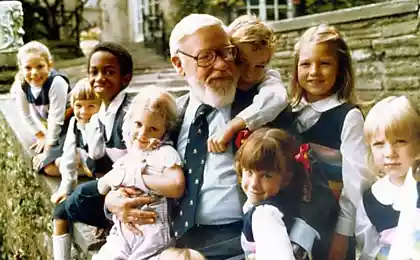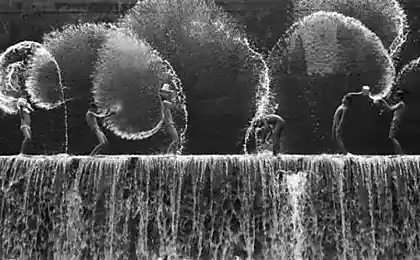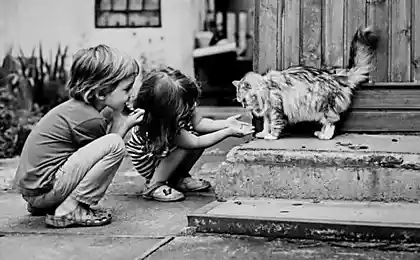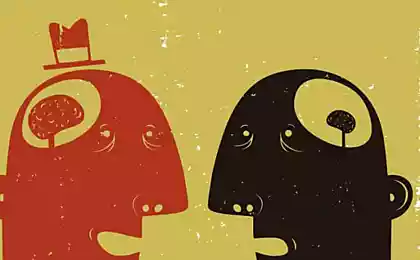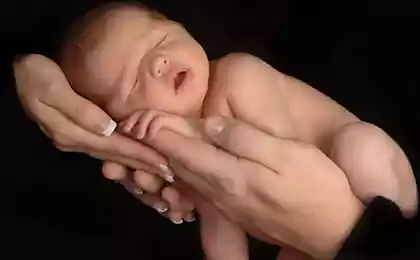669
Glenn Doman: to Give children unlimited opportunities in life

The methodology of our contemporaries, an outstanding American doctor Glenn Doman heard many. She has a lot of followers, but also many opponents.Many people were taken for this work, has obtained questionable results or even not received, saw the reluctance, the resistance of children against this method of presenting information, as a result, contracted from home ideas of early development, have changed the technique beyond recognition and received the, as, for example, all famous French mother Cecile Lupan.
Of course there are people who like this technique in its pure form, which do not want to change and do not want any step to deviate from the written in the book. There is some debate if it's good or not, when to start and how. People get lost in front of a huge amount of work to be done. Many people forget that there are probably other ways of teaching children, and when they fail to work in the Domani, and they did leave to have children.
From history. In the late forties American military doctor Glenn Doman, working at the Philadelphia Institute, later called the "Institute of the accelerated development of the child" ("Better Baby Institute" (BBI)), began to treat children with brain injuries. The conclusions to which he, along with the staff came, can be schematically described as follows: by stimulating one of the senses, it is possible to achieve a sharp increase of brain activity in General. First of all sick children (except the blind) have been taught to read by showing them cards with words written in very large red letters, these words aloud aloud. The entire lesson took 5-10 seconds, but such lessons on the day had a few dozen. With blind children, the situation was more complicated — the first step of the program was to give them the opportunity to see at least the outlines. As a result, when these children began to read, in parallel, gradually, little by little, they started to move. To learning by the method of Doman, these children lagged behind in all indicators of physical development of children, and some time after the start of training — weight, height, circumferences of head and chest is 20% higher than ordinary children!
The system, designed for patients, Doman tried to apply in work with healthy children. For his works he showed that the human potential is enormous, even at a very early age kids can really learn a lot. In his Institute children two, three, four years you start to read, perfectly learn the math, become real scholars, and however well developed physically: they swim well, run, climb. The creative possibilities of these children is so broad that the Doman calls them children of the Renaissance.
The essence of the methodology. The goal that we set ourselves Doman, is "to give children unlimited opportunities in life. But the implementation of this goal will be determined by what will choose for themselves a child, whom he decides to become like him from a long list of possibilities." Doman knows that learning is effective only during the period of brain growth. But the human brain grows to seven or seven and a half years, but just stronger it grows in the first three years. On this basis, their system he built for three or four years old kids.
Glenn Doman postulates the priority of visual experience over all other ways of knowing the world. From the first days of life to children show a series of cards on different branches of knowledge, from the written words, the cards with points (mathematics) and ending with the image of plants, animals, great men and historical events, and more. According to Doman, similar advanced training encourages the development of different parts of the brain and so the child develops much faster than his peers. Books Doman infect the reader. Just want to start doing so, as it is written.
Doman has developed a system of physical development of the child. In the first place, says Doman, it is necessary to give the child the opportunity to move from the first days of life. Simple efforts can lead to the fact that in the first month of life the child will crawl several meters per day. This greatly affects the development of child's abilities. Of course, we must teach in a way that is psychologically comfortable for the child, we must try gradually to develop his innate reflexes.
Children who are swaddled, most of them more apathetic, do not allow themselves to do what they want, at a later age than children who are allowed and helped to move the way they want. Have you ever seen, what joy is written on the face of a three-month baby boy, who is made to stand and walk? If Yes, then You will never say that this early development is harmful. Doman recommends teaching him to do everything possible to turn and twist it in various ways. Developing child thus, during the first year of life can make a very strong Foundation for all his future life. And this is confirmed by the two athletes in many sports the leading position due to the fact that they picked up the racket, went out on the ice or started to swim no later than two years.
In addition, Glenn Doman believes, and it's checked to them on the sick children that encourages physical development and mental development. When the child reaches a year, it is necessary in parallel with physical development to begin to develop such capacities as linguistic, mathematical and others. According to Doman, linguistic abilities — innate function of the human brain. He believes that all babies have an incredible talent for languages, able to master early reading. Glenn Doman highlights the facts that make up languages. They are called words, numbers or music, depending on what language is spoken.
He believes that in regard to the learning of bare facts, children can learn everything we give them. Moreover, the younger they are, the easier they learn. Based on this, the idea of "readiness for reading" (as well as all other "readiness") is utter nonsense. The allegation that the child is ready to read at five or six years, not only absurd, but dangerous. Readiness builds in children, and if not created accidentally or with a purpose — she does not appear at all.
Doman believes that if the child to learn factual material in mathematics, and the facts that are the basis of mathematics, are numbers such as one, two, three, four, five, six, he opens a mathematical rule such as addition, subtraction, multiplication, division, etc. From this he concludes that mathematical ability is an integral function of the human brain. Learning math is that the child show cards with large red dots (five pieces) and loudly call their quantity. Doman shows the number of points, not number, to ensure that the child could feel the real number, not an abstract badge of figure. When the child will be the first twenty digits, to it, except the figures start to show examples. Most of the children who carefully examine what they show, about a couple of months can visually distinguish points from 56 to 57 and solve a simple example.
Besides learning reading and math Glenn Doman recommends to give and encyclopedic knowledge. To do this, parents make a selection of cards depicting plants, animals, great people and much more. It would probably be nice if baby didn't just give encyclopedic knowledge, but also tells where and how they are used, how they are interconnected, supported by examples from life (then the information becomes less impersonal, and therefore more interesting for a child).
How is the training? Doman recommends that you show each card, regardless of what it depicts, for 1-2 seconds. Thus, the whole lesson takes 5-10 seconds. It is believed that it is better to show as soon as the child has time to look at all components of the image, i.e. words and fast and painting is slow. To teach reading Doman takes the old Anglo-German system: the sight and sound of the whole word. He recommends to show cards with written on them in red words on a white background. Doman advises to begin training as early as possible, it is better — up to a year. But at this age the child still knows little of the names of the items, and in this case he recognizes them from cards, and learns only the name without the image of the subject. If he already has formed the relationship between image and object, he probably still can not imagine the word object (because too fast show and often change words, he does not have time to get used to them).
It turns out that we, from a very early age, teach a child to think abstractly. How about figuratively? By the way, children with imaginative thinking this technique do not take. I think it would be better if it showed simultaneously on a single sheet from the top picture, bottom is signed. As children get older Doman proposes to increase the duration and number of sessions. At the age of 1.5-2 years with it starting, for example, to study the Japanese language, to acquaint him with modern art or learn to play the violin.
As with any methodology, and techniques Doman has its negative sides. The main one is that if you use this technique, the child of an active participant in the learning process turns into its object. During training the child is passive, only works its visual system, encompassing the information located on the cards. The kid is loaded with facts (making him "the walking encyclopedia"), but not taught to think (use the knowledge). Suffering emotional and cognitive development, because it is impossible to develop only one (in this case visual) component. The "fact" need to feel, to touch and to lick, i.e., to explore it with all the senses, and then, using its relationships with other "facts," to determine his place in the world. But, unfortunately, the technique is very laborious and impracticable, as it takes the lion's share of time in the child, leaving no possibility to just run, play. By the way, Doman is a categorical opponent of toys, considering that they only wasted precious time.
The whole method of Glenn Doman is one big comic book, built on the principle of image signature. The children are accustomed to perceive information, it's just not gonna be able to listen to the text without pictures, they each offer will need a picture. Otherwise, they will begin to miss you. And because this is all being laid at a very tender age, and learned this method of obtaining information is fast. Perhaps for Americans is a step forward. Baby don't just make comics and tell something important and necessary. And for the Russian educational and cultural traditions is a big step backwards. You open any Russian book art, science-fiction, textbook — there will be a lot of text and few pictures or none at all. And we read these books and enjoy. But if our children get used to the fact that only the picture is interesting, and what is written — if it's longer than one sentence should not read as long and boring. We will lose their cultural traditions, their great literature. Look at the current students — all teachers complain that children do not read, and most importantly do not want to read. And as a result the children make the letter a monstrous amount of stupid mistakes, what would never read a child because, having met this word many times in the books, he is likely to remember how to write. These children, though not brought up from birth in the techniques of Glenn Doman, but the parents, most likely, read simplified books with large and beautiful pictures, which in the last decade has been published and republished from foreign models a huge amount. At the present the children were overwhelmed comics primitively children's magazines, depleting children's minds.
To exacerbate the tragedy of the situation, I would say that if a kid with childhood accustomed to the consumer way of getting information — wait and see, growing up, for example, by the techniques of Glenn Doman, this way the continued existence of the primitive movies, books, children's encyclopedia, where two words or three pictures — all of this will fall on good soil. And the baby even if I wanted to then read a more serious book, he just gets tired quickly or will cease to understand anything.
What is the way out of this. How to give your child encyclopedic knowledge? How not to harm, not to overreact? How to get confidence? There are a number of short reflections on this subject:
1. if you want to give your baby encyclopedic knowledge, it can be done not only by the method of Glenn Doman;
2. if you want to do it still with this method, you do not worry if something will not work;
3. never follow all the advice that you give, it refers to the books of Glenn Doman, to other books and what is written here, leave yourself room for creativity, move everything on the head and do everything on its own;
4. if you want to do something with the child to put it on skis, to learn to read or to give the child a deep knowledge, first of all, decide for yourself what you need, that is, set goals, and then select the means by which you could achieve your goals;
5. you should never do what you don't like, and what you think, do not like your child;
6. engage with your child as much as you get and it will be better than nothing; never blame yourself, that is something you have not done, guilt is not the best;
7. it is not necessary to ask a child to give you the answers, to play with you, read to you, when he has no mood;
8. the main thing — try talking more with your child, talk to him about everything is the key to your success;
9. give him as many ways of obtaining information, not just cards or something a fashionable craze;
10. the information you give to a young child, needs to be built based on the principle of "the Child and his environment" and its boundaries should be expanded depending on the age of the child;
11. try to not give fragmented information that is not individual facts, and systematically organized information
12. let's take it from different angles, from different points of view, illuminate one topic not only on cards, but in games, posters, books, and other benefits;
13. do not hammer the child's head with useless information that only gives an unnecessary burden on the brain; an example of such information can serve as: a variety of "educational" TV shows like "sesame street" and many, especially imported cartoons, do not give anything to the mind and thoughts of a child; comics, books little-known and absolutely unknown authors, telling about the colorful animals, different Bolkiah and Blotches; scattered encyclopedic knowledge, not having continuations — that is, if you are not able to use this information or develop it in further education, it is better not to give because you have so much more information, without which it is impossible to move on;
14. help your child learn to extract information;
15. give your child creative freedom in the process;
16. rejoice in each success your child has even the slightest attempt to prove themselves, especially if it is for the first time;
17. improve yourself, never stop.
Now about the positive aspects. The method is good because the child learns a large amount of information a pleasant way for him. And for the development of creative and research abilities it is possible to apply other techniques. And besides, a big plus is that Glen Doman educates parents, explains that children have a lot to do. The main thing, in what Doman is undoubtedly right, is that the younger the child, the easier he or she can absorb new knowledge. You need to have time to take advantage of this. You can even leave the system card, as the kids are very fond of pictures, but only changing the approach to the organization of classes and adding to the creative and research activities, educational games. The quality of the method is confirmed by its results: in the world there are several dozen Nobel laureates, who in his childhood he studied at Domani.published
Author: Anna Boyarintseva
P. S. And remember, only by changing their consumption — together we change the world! ©
Source: www.magichild.ru/St/doman.htm
A classic of the genre: cranberries in powdered sugar
Conscious sports: the mechanism of each muscle

